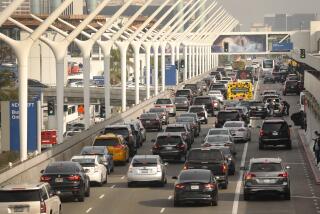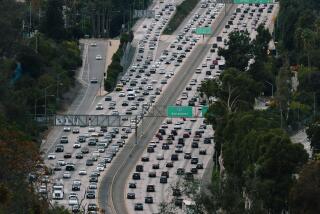Spring Forward, Fall Back--and Brace for Monster Traffic Jam : Congestion: The crunch was not limited to automobiles. The RTD reported an increase in bus ridership as well.
It is a phenomenon that occurs every year, and no one seems to know why: On Sunday, clocks were moved back an hour as daylight-saving time ended, and on Monday morning Southern Californians found themselves locked in horrendous traffic jams.
“It happens every year,” said Bill Keene, a 14-year veteran of freeway traffic reporting in the region. “You can always count on some of the heaviest traffic of the year with the time change, more so with this change than with the one in the spring. I can’t tell you why, but it happens.
“This morning it was a particularly brutal day from the time I got in (at 5 a.m.). There were constant complaints of bumper-to-bumper traffic. That’s unusual, even for a Monday.”
At Caltrans’ traffic operations center in downtown Los Angeles, an electronic board that monitors traffic flow indicated numerous traffic snarls.
“We don’t have an explanation, it’s just due to a lot of traffic,” said Margie Tiritilli, spokeswoman for the department. “Since the weather is nice, we certainly can’t say it’s due to wet or rainy weather, so it may be that people didn’t set their clocks back for whatever reason. But it’s going to get worse this evening. It always does.”
Indeed, Caltrans reported that the homebound commute began haltingly half an hour earlier than usual. Officials offered no explanation.
Lt. Dennis Sterling, who is in charge of the traffic coordination section for the Los Angeles Police Department, said police anticipated more accidents Monday night--”I guess because people aren’t used to going to home in the dark.”
The city’s Department of Transportation was also braced for a hectic commute.
“What we anticipate is this evening, during the peak hours, there will be more cars on the freeway,” said Kaye Beechum, a parking enforcement manager for the city. “A lot fewer people car-pool, for whatever reason. Maybe they don’t want to car-pool when the time changes, possibly just because it’s darker. I don’t understand why. This happens once the time changes, but we don’t see the same phenomenon in the spring.”
The crunch wasn’t restricted to automobile traffic. The Rapid Transit District reported more bus riders hopping on buses earlier in the morning than usual, said John Hilmer, acting manager of operations planning for RTD.
“My supposition is that people are awake earlier and they will want to get to the office a little earlier,” he said. “That’s not me, though. If I wake up a little earlier, I want to do things around the house instead of going to work earlier. But, yes, generally that will occur. It’s not a substantial amount, but there is a noticeable shift to slightly earlier.”
In turn, he said, there will be more riders returning home on earlier trips, possibly because commuters want to avoid getting home in the dark, he said.
Chaytor Mason, a USC psychologist, said that there are slight adjustments to make on the first day of returning to the working world after the clock has been turned back one hour.
“It’s not really too bad--one hour. But if you want to nit-pick, it is a little different,” he said. “There is some problem in that we do use different cues in the daytime than we do in the dark, so it may take a little time to shift over. People may be likely to miss off-ramps, for example. You might make more mistakes, but nobody gets killed as a result of it, really.”
Linda Glazner, an assistant professor at the UCLA School of Nursing, who has studied sleep patterns, said that if there are differences in traffic patterns, there is no evidence to show they are related to the change in daylight-saving time.
“Maybe it’s just because it’s the fifth Monday of the month,” she said.
More to Read
Sign up for Essential California
The most important California stories and recommendations in your inbox every morning.
You may occasionally receive promotional content from the Los Angeles Times.










